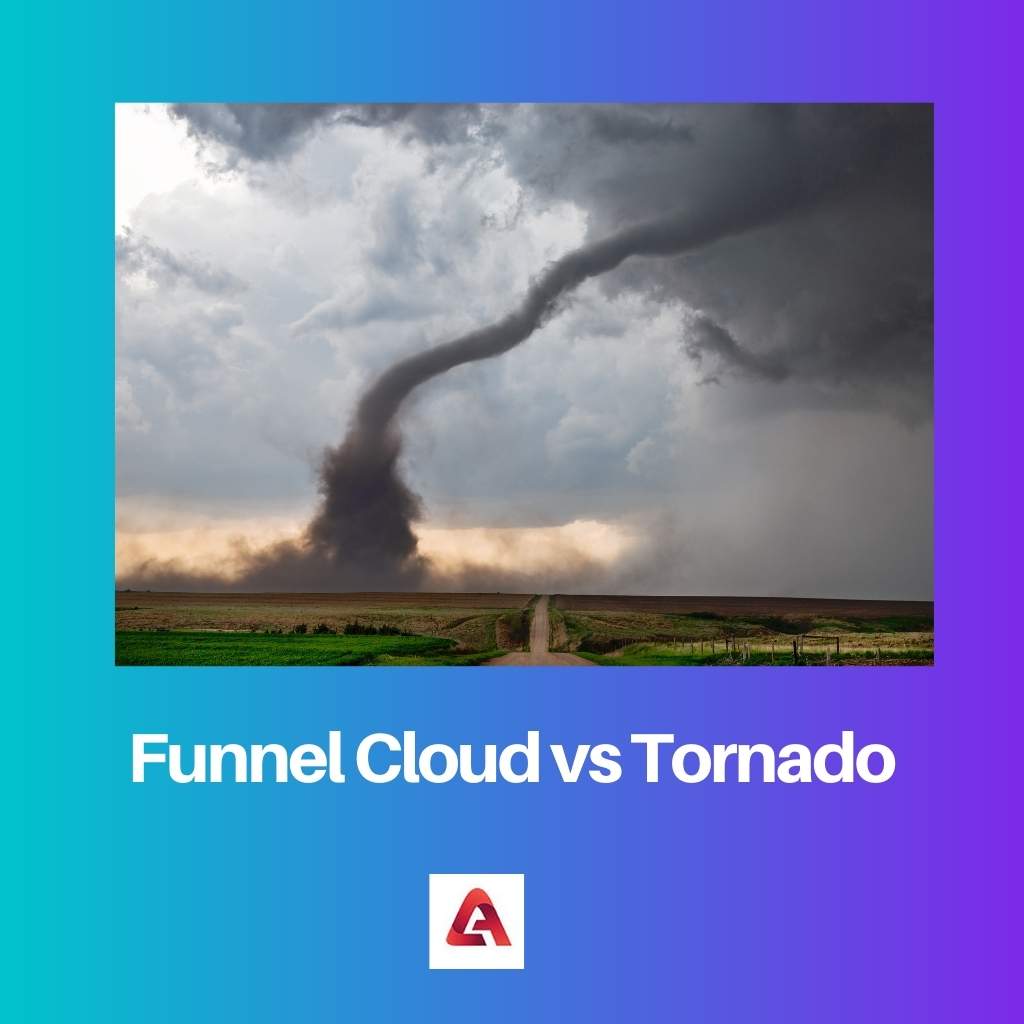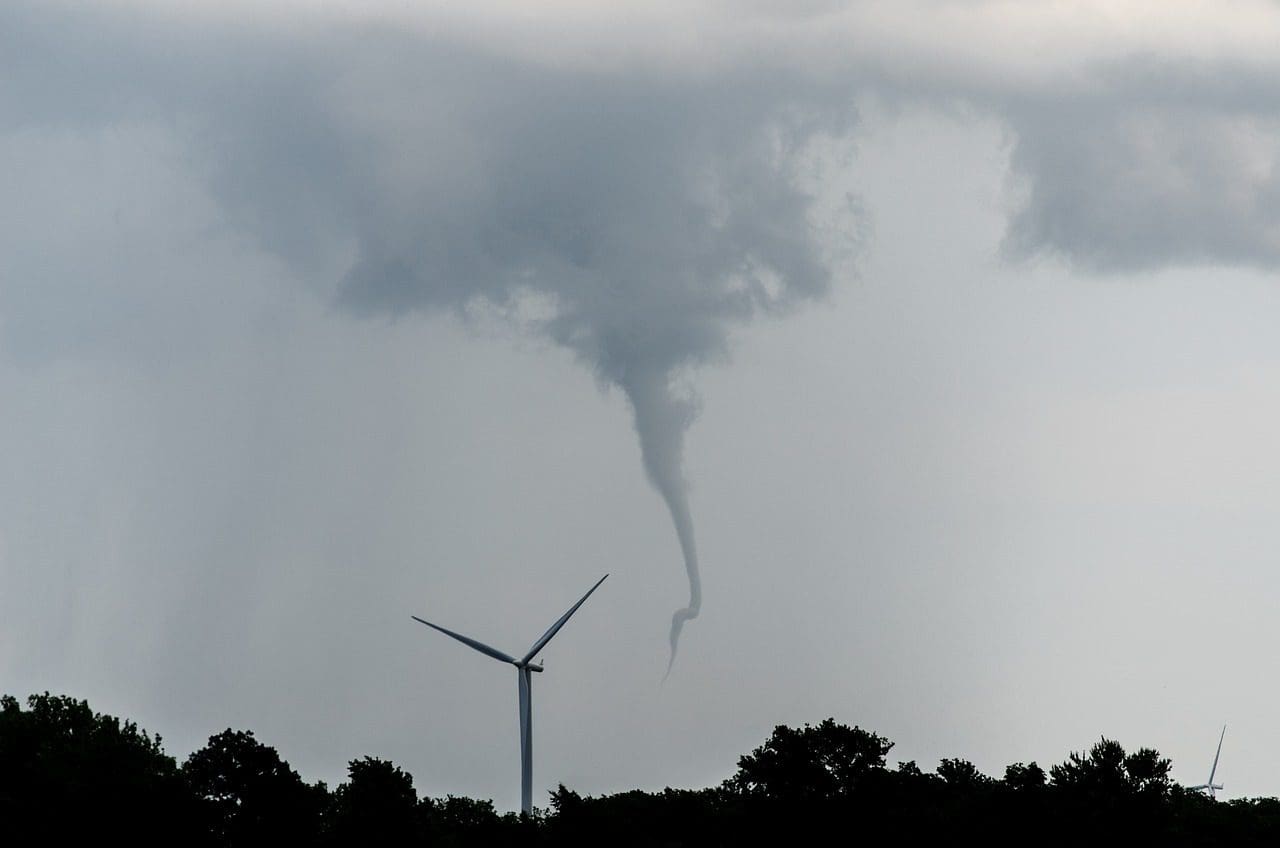It seems as if natural calamities have now become a part of human existence, striking countries, states, or any other part of the earth. Natural disasters also destroy the planet and humans, and no power in the universe can stop them from happening.
Therefore, it is necessary to understand them so you can be cautious when it happens. Phenomenons that occur most frequently are thunderstorms, tsunamis, and earthquakes.
Here, two of the very common thunderstorms are distinguished, i.e. Funnel Cloud and Tornado.
Key Takeaways
- A funnel cloud is a rotating column of air that does not reach the ground, while a tornado is a rotating column of air that touches the ground.
- A funnel cloud is not as strong as a tornado and may not cause as much damage, while a tornado can be mighty and destructive.
- A funnel cloud may appear transparent, white, or grey, while a tornado appears dark and is accompanied by debris and dust.
Funnel Cloud vs Tornado
The difference between Funnel clouds and Tornadoes is that they vary in density. Funnel clouds are denser and form a distinctive funnel-like shape, thus named so. Tornado, on the other hand, is lighter and looks like a fast-running vortex. Funnel clouds barely touch the surface of the ground, and when they do, they convert themselves into a tornado.

The funnel cloud gets its name from its shape. Funnel clouds are funnel-shaped vortexes of heavy water vapours with air spinning at higher speeds.
Funnel clouds can form under rain clouds if it has sufficient vorticity and humidity in the air. There are two types of funnel clouds, namely landspouts and waterspouts, which can reach the ground but are weak to cause any harm.
A tornado is a sharp rotating column of air that can reach the ground. Tornadoes form in the case of thick clouds or, in rare cases, cumulus clouds.
A tornado is also a type of funnel cloud but is lighter in weight and has better vorticity to move even faster than other funnel clouds. Tornados are more easily visible because they travel in the greyish-dark sky.
Comparison Table
| Parameters of Comparison | Funnel Cloud | Tornado |
|---|---|---|
| Shape | The funnel cloud appears to look like a cone-shaped or funnel-shaped column of air that rotates at a medium pace in the sky. | Torneos is a long cylindrical column of air or pillars or wedges that moves faster than the funnel cloud in the sky as well as on the ground. |
| Composition | Funnel clouds comprise condensed water vapour. | A tornado is formed by a cluster of water droplets, dust, debris, and other particles from the ground. |
| Types | There are various types of funnel clouds, namely Cold air columns, waterspouts, and landspouts. | Some of the most popular tornado types are known as Landspout, waterspout, multiple vortex tornado. |
| Velocity | Funnel clouds are weak thunderstorms that last only a few seconds and can travel at a speed of less than 40mph. | A tornado is powerful when it hits the earth’s surface and can run with a speed between 50mph to 360mph. |
| Occurrence | Funnel clouds wind occur around the mountain regions when comes in contact with cumulus clouds. | A tornado is a combination of wind that occurs when moist and hot air meets dry and cold air, and together, they make a cluster of air mass that causes instability in the atmosphere. |
What is Funnel Cloud?
Funnel clouds are also known as “Tuba”. These are the spinning vortex of clouds that travels towards the ground but never reach the ground.
These clouds are distinct in their shape- sharp cone-shaped clouds.
Funnel clouds are formed in places with low pressure; thus, they can easily combine with condensed water droplets and form a thick mass of air around the cloud or at the base of the cloud.
Weather with cumulonimbus clouds is also associated with a funnel cloud. They are the potential host for forming funnel clouds.
In other words, whenever there is a funnel cloud, heavy rain, lightning, or thunder is always expected. And, if the tuba gets in contact with the earth’s surface in any care, it might turn into a tornado, and the nearby regions could be at risk of damage.
These funnel clouds, when formed over large water bodies like the ocean, turn into waterspouts and cause severe instability in the water bodies as well.
The formation of funnel clouds depends on the overall condition of the atmosphere. If the air is less humid and dry, the chances of forming a condensation funnel are very low, whereas if the air is moist and has cold conditions, you would see an intense funnel cloud formation.
Funnel clouds can travel up to a speed of 40mph to 45mph and stay in the sky for a few seconds o a few minutes.

What is Tornado?
Tornado has different names in different countries, but the most used names are “cyclone”, “twister”, and “whirlwind”. They make contact with the ground and swirl around the surface while carrying water droplets, dust particles, debris, and other light components along with them in the atmosphere.
A tornado is also referred to as a funnel cloud when the funnel cloud touches the surface of the earth. Tornadoes are strong columns of air that rotate along the vertical axis and are visible to the naked eye.
The major reason for the formation of a tornado is wind shear. Wind shear is nothing but changes in the wind’s direction, height, and speed, and when it happens, it creates a horizontal spinning effect around the clouds.
Typically, such kind of wind is formed when the hot air and cold, dry air combine.
Tornadoes occur in several places, but their keen place is in the United States. The USA has the highest number of tornado occurrences in a year than any other country in the world.
Interestingly, there’s an area in the United States where the concentration of tornadoes is the strongest and thus named “Tornado Alley.
Tornado travels at a speed of 500km/h in the peripheral areas thus, has the potential to cause serious damage in the vicinity. A tornado lasts for a few minutes to more than half an hour.

Main Differences Between Funnel Cloud and Tornado
- A funnel cloud is a rotating column of air that does not reach the ground, while a tornado is also a rotating column of air but capable of touching the ground.
- Funnel clouds have less travelling speed, whereas tornadoes have high travelling speeds.
- Funnel clouds are formed by heavy condensed water droplets. A tornado is formed with a combination of water droplets, debris, and dust.
- Funnel clouds travel on the vertical axis, whereas tornadoes can travel on both the axis.
- Funnel clouds make thunder sound like a jet engine, while tornadoes have more like a roaring sound.

- https://journals.ametsoc.org/view/journals/mwre/99/11/1520-0493_1971_099_0877_sofcoa_2_3_co_2.xml
- http://www.nativeamericanembassy.net/TREATIES/digital.library.okstate.edu/OAS/oas_pdf/v58/p81_86.pdf

The distinction between the compositions of funnel clouds and tornadoes offers a clear view of their structures and how they differ from each other. This is valuable meteorological knowledge.
I appreciate the detailed comparison of the composition and velocity of funnel clouds and tornadoes – it provides a comprehensive understanding of their distinct features.
Indeed, understanding the specific elements that contribute to the formation of these atmospheric occurrences enhances our awareness of their inherent characteristics and behaviors.
The explanation of the formation and potential consequences of funnel clouds and waterspouts offers a clear understanding of the environmental impact of these atmospheric phenomena. This is valuable scientific knowledge.
Indeed, the scientific details provided in the article enhance our awareness of the behavior and characteristics of funnel clouds and waterspouts, contributing to our overall understanding of these natural events.
I found the insights into the formation and transformation of funnel clouds into waterspouts very interesting. It’s important to recognize these meteorological occurrences and their potential implications for the environment.
The comparison table is very helpful to differentiate between funnel clouds and tornadoes. It clarifies their characteristics in a concise manner.
Agreed, the detailed comparison makes it easier to understand and remember the key differences between the two meteorological phenomena.
The explanation of the formation of funnel clouds and their association with cumulonimbus clouds provides a comprehensive understanding of their origin. The meteorological details are fascinating.
It’s intriguing to learn about the atmospheric conditions affecting these phenomena. This article presents the information in a very understandable way.
Absolutely, the scientific insight into the formation and behavior of funnel clouds and tornadoes is very enlightening. It’s important to have this knowledge for personal safety and awareness.
The comparison of funnel clouds and tornadoes, along with the distinctions in their velocities and occurrence conditions, provides a comprehensive view of these atmospheric phenomena. It’s crucial knowledge for understanding and responding to these natural events.
Absolutely, the detailed meteorological analysis in the article enhances our understanding of funnel clouds and tornadoes, contributing to greater awareness and preparedness for these natural occurrences.
The detailed differentiation of funnel clouds and tornadoes, along with their key characteristics, clearly outlines their unique traits. This information is vital for recognizing and responding to these natural events.
Absolutely, the specific details provided in the article enable readers to gain a deeper understanding of these meteorological phenomena. It’s essential knowledge for everyone to be informed about.
The detailed comparison and characteristics of funnel clouds and tornadoes provide important insights for recognizing and addressing these natural events. It’s essential to have this level of understanding and awareness.
Indeed, the scientific details and comprehensive analysis presented in the article offer valuable knowledge about funnel clouds and tornadoes, enabling readers to gain a deeper understanding of these meteorological occurrences.
The explanation of the varying density and appearance of funnel clouds and tornadoes offers an insightful perspective on the differences between the two weather phenomena. Very informative content.
Agreed, the article effectively presents the distinctions between these atmospheric occurrences. It’s great to have this level of explanation and analysis.
Natural disasters can be catastrophic, it’s crucial to understand them to stay safe. The differences between funnel clouds and tornadoes are very interesting and informative.
Yes, learning more about these natural calamities can help us be more responsible and prepared when they occur. Great explanation!
The description of funnel clouds and their association with low-pressure conditions and cumulonimbus clouds adds a layer of depth to the understanding of these meteorological events. It’s enlightening to learn about these atmospheric intricacies.
Absolutely, the meteorological insights into the formation and characteristics of funnel clouds provide a valuable perspective on these natural occurrences.
I appreciate the detailed explanation of how funnel clouds are formed and the potential risks associated with them. It’s important to be aware of these meteorological phenomena and their potential impact.